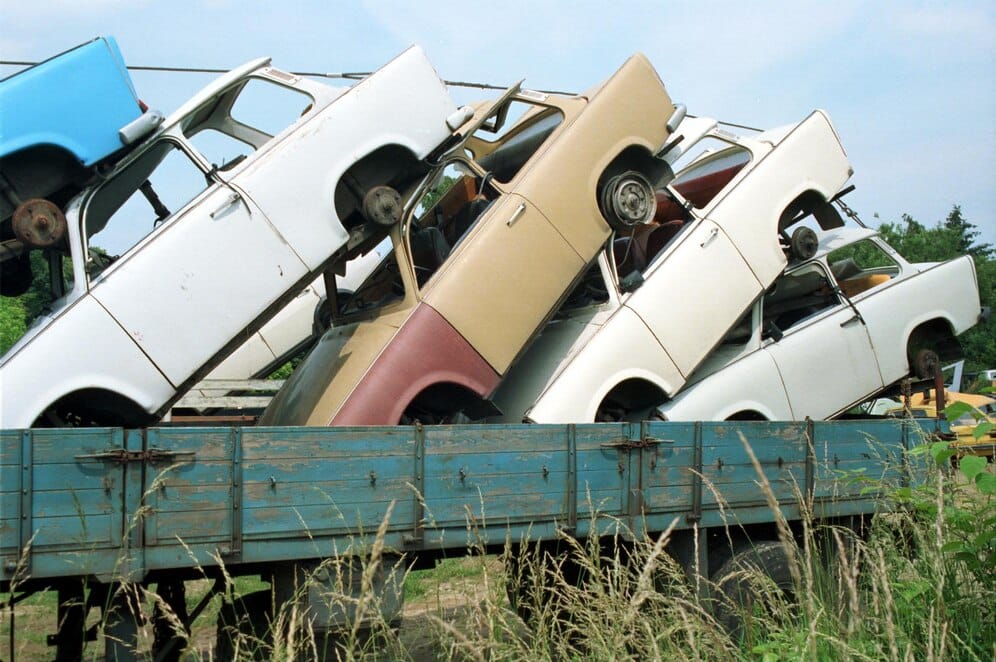
For many Canadians, saying goodbye to an old vehicle can feel like parting with a piece of their history. Whether it’s the first car you ever owned or the trusty ride that carried you through countless road trips, these vehicles often hold sentimental value. But when the maintenance costs outweigh the benefits, it’s time to consider the best way to let it go.
Over the years, programs like cash-for-clunkers have made it easier for owners to turn their outdated vehicles into cash. Even if your vehicle is in poor condition, it still holds value—whether through selling, donating, or recycling. Our guide is here to help you navigate this process with ease and confidence.
Understanding the state of an older vehicle can help owners make informed decisions. These vehicles often face challenges like neglect, damage, and high maintenance costs. Over time, parts deteriorate, and mechanical failures become more frequent, making them difficult to maintain or sell.
A clunker is typically a vehicle in poor condition, often with significant wear and tear. Common issues include rusted frames, faulty engines, and worn-out transmissions. These problems not only reduce the vehicle’s functionality but also its resale value. For many owners, the cost of repairs outweighs the benefits of keeping it.
In the past, terms like "jalopy" and "beater" were used to describe older, neglected vehicles. These cars often held cultural significance, such as in jalopy racing during the 1930s. Today, market conditions and state regulations have shaped how these vehicles are maintained or disposed of. For example, programs like cash-for-clunkers have encouraged owners to retire their outdated vehicles responsibly.
The industry has also adapted, offering more ways to recycle or salvage parts from older vehicles. This not only helps reduce waste but also provides owners with a way to recover some value from their clunkers. By understanding these trends, Canadians can make better decisions about their older vehicles.
Determining the worth of an older vehicle can be a crucial step in deciding its future. Whether you’re looking to sell, donate, or recycle, understanding its value ensures you make the most of its potential. Let’s explore how to assess your vehicle’s condition and explore your options.
Start by checking the price of your vehicle based on its year, mileage, and overall condition. Vehicles with fewer mechanical issues and well-maintained parts often fetch higher prices. For example, popular models like the Honda Accord or Toyota Camry may have higher demand for their parts.
Obtain quotes from a trusted dealer or independent appraiser. Many online platforms offer same-day quotes, making it easier to compare offers. Leverage customer feedback and industry benchmarks to ensure you’re getting a fair deal.
Market demand can influence your vehicle’s worth. For instance, scrap metal prices vary regionally, affecting the overall value of your vehicle’s materials. Understanding these factors helps you maximize your return.
Finally, consider the time your vehicle has spent on the road. Older vehicles with high mileage may have reduced value, but functioning parts can still add to its worth. By evaluating each element—from price to part condition—you can make an informed decision about your vehicle’s future.
Exploring your options for vehicle disposal can lead to financial and environmental benefits. Whether your auto is no longer running or you’re simply ready for an upgrade, there are three main paths: selling, donating, or recycling. Each method has its own advantages, and understanding them can help you make the best choice.

Selling your vehicle directly can be a great way to get cash quickly. Start by gathering all necessary documents, including the title and maintenance records. These papers help establish trust with potential buyers.
Next, assess your vehicle’s price based on its condition, mileage, and market demand. Use online tools or consult a trusted dealer for an accurate valuation. Advertising your vehicle on platforms like Kijiji or AutoTrader can attract serious buyers.
Finally, schedule inspections and test drives. Be transparent about any issues to avoid disputes later. Once sold, ensure all paperwork is completed to transfer ownership legally.
Donating your vehicle can be a rewarding option. Many charities accept vehicles, even if they’re not running. Programs like cash-for-clunkers or the car allowance rebate system can turn your old auto into support for community needs.
Donations often come with tax benefits. For example, if your vehicle sells for over $500, you can claim the sale amount as a deduction. Free towing services, like those offered by Homeless Cars, make the process hassle-free.
Recycling is another eco-friendly choice. Approximately 75% of a vehicle’s parts can be reused or repurposed. Professional service providers dismantle the vehicle, salvaging usable materials and reducing waste.
Each disposal method offers unique advantages. Selling provides immediate cash, while donating supports charitable causes and offers tax breaks. Recycling benefits the environment by reducing landfill waste.
Here’s a quick comparison to help you decide:
| Method | Benefits | Considerations |
|---|---|---|
| Selling | Immediate cash, control over price | Time-consuming, requires paperwork |
| Donating | Tax benefits, supports charities | Lower financial return |
| Recycling | Eco-friendly, parts salvage | Limited financial gain |
By weighing these options, you can choose the method that aligns with your goals. Whether it’s cash, tax benefits, or environmental impact, there’s a solution for every vehicle owner.
When it comes to disposing of an old vehicle, legal and environmental considerations are key. In Canada, each province has specific rules to ensure the process is safe and compliant. Understanding these regulations helps you avoid penalties and contribute to environmental sustainability.

Provincial rules vary, but they all aim to protect the environment and ensure proper disposal. For example, in Ontario, the Environmental Protection Act governs how vehicles are recycled. This includes rules for handling hazardous materials like oil and batteries.
In British Columbia, the Scrap It Program encourages owners to recycle older vehicles responsibly. These programs often provide incentives, such as rebates or discounts on new purchases. Checking your province’s specific guidelines ensures compliance.
Transferring the title is a critical step. This document proves ownership and must be signed over to the new owner or recycling facility. Cancelling your registration is equally important to avoid future liabilities.
Keep records of the date and time of disposal. These details may be required for legal or tax purposes. Proper documentation protects you from potential disputes or claims.
Recycling a vehicle reduces waste and conserves resources. Many parts, like metal and glass, can be reused. Professional service providers ensure hazardous materials are handled safely, protecting the environment.
By following legal and environmental guidelines, you contribute to a cleaner, healthier planet. It’s a small step with a big impact.
Disposing of an older vehicle doesn’t have to be a hassle—with the right strategies, it can be a smooth and rewarding process. Whether you’re looking to sell, recycle, or donate, these expert tips will help you maximize your return and make the most of your vehicle’s value.
Seasoned auto dealers recommend starting with a thorough evaluation of your vehicle’s condition. Factors like mileage, age, and demand for specific models can significantly influence its worth. For instance, vehicles under 10 years old often fetch higher prices due to their parts’ usability.
Negotiating with a trusted dealer can also yield better offers. Many dealers provide same-day quotes, making it easier to compare and choose the best deal. As one expert noted, “Transparency about your vehicle’s condition builds trust and ensures a fair transaction.”
Programs like the car allowance rebate system can turn your old vehicle into cash or rebates. These initiatives often offer incentives for environmentally friendly disposal methods, such as recycling. For example, up to 85% of a vehicle’s parts can be reused, reducing waste and benefiting the planet.
Here are some actionable steps to maximize your return:
By combining expert advice with these strategies, you can ensure a hassle-free and profitable disposal process.
Taking the next step with your old vehicle can be both rewarding and straightforward. Whether you choose to sell, donate, or recycle, each option offers unique benefits. Evaluating your vehicle’s value ensures you maximize your return, while considering market demand can help you make informed decisions.
Legal and environmental responsibilities are equally important. Properly transferring the title and ensuring compliance with provincial regulations protects you from future liabilities. Recycling your vehicle also contributes to a cleaner environment by reducing waste and reusing valuable parts.
Don’t forget to explore rebate programs like the allowance rebate system, which can turn your old vehicle into cash or incentives. These programs not only benefit you financially but also support sustainable practices.
We’re here to help every step of the way. If you’re unsure where to start, reach out for expert advice and make the process seamless. Your old vehicle still holds value—let’s make the most of it together.
A clunker is typically an older model in poor condition, often with high mileage or mechanical issues. The challenges include low market value, difficulty in selling, and potential environmental concerns.
Start by evaluating its condition, mileage, and market demand. Online tools and professional appraisals from auto dealers can help determine its worth.
You can sell it privately, trade it in at a dealership, or use online platforms. Each method has its pros and cons, so choose based on your timeline and desired return.
Yes! Donating to charities or recycling through certified centres are great options. Both methods can provide tax benefits and help the environment.
Ensure you transfer the title properly and follow provincial regulations. This includes notifying your local motor vehicle department and obtaining necessary documentation.
Some provinces offer rebates through programs like the Car Allowance Rebate System (CARS). Check local guidelines to see if you qualify for cash incentives.
Experts suggest researching your options, comparing offers, and ensuring all paperwork is in order. This helps maximize your return and simplifies the process.